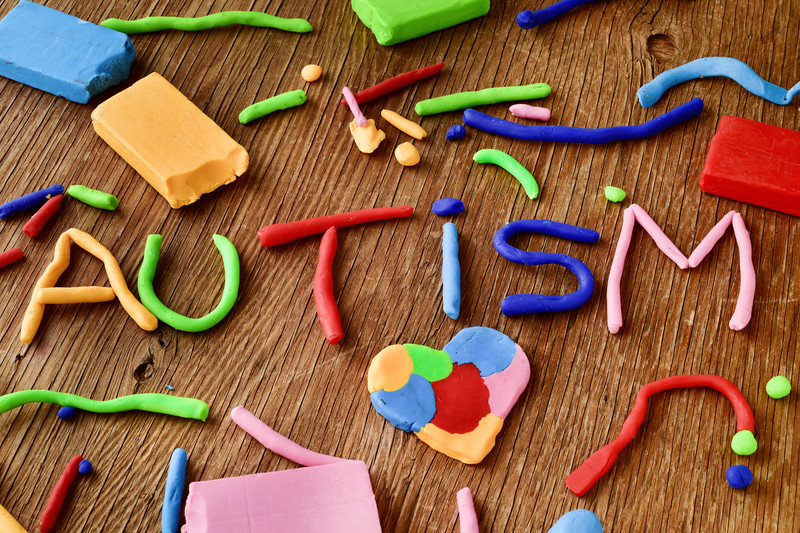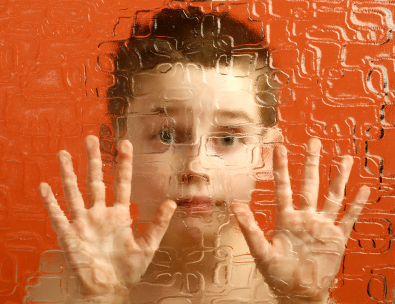The first appearance of autism in historical literature was in 1911 by Eugen Bleuler, a psychiatrist from Switzerland, who used the term to describe a unique cluster of symptoms that were traditionally thought to simply be symptoms of schizophrenia (Bleuler also coined the terms schizophrenia and schizoid and was a contemporary of Freud; his students were at some point in time Carl G. Jung and H. Rorschach).
Coming from the Greek word “autos” which translates as “self” autism was originally used to describe extreme social withdrawal that was common with psychiatric diseases that presented with psychosis. Simply put, the person is removed from social interactions, thus becoming an “isolated self”. Although it is now known that autism and schizophrenia are two distinct disorders, autism was not classified as its own disorder in any diagnostic manual until 1980.

Among the many frustrating things about autism is that no one knows its cause! – though a number of risk factors, both genetic and environmental, have been identified. Another frustration is that the definition of what autism is keeps expanding. Some researchers are saying that because of this expanding definition we have a higher prevalence of a disease when in facto, there is no rise in autism.
According to the latest estimates, in USA, about 1 in 59 children has been identified with autism spectrum disorder (ASD) and about 4 times more common among boys than among girls.
In Canada, based on 2015 data, it is estimated that 1 in 66 Canadian children and youth ages 5-17 have been diagnosed with ASD. It is estimated that males are diagnosed with ASD four times more frequently than females.
Most children were still being diagnosed after age 4, though autism can be reliably diagnosed as early as age 2.
Autism affects all ethnic and socioeconomic groups.
Risk factors for autism?
Prenatal (environmental) factors: These may play a role before and during childbirth. Those with the greatest evidence of an increased risk of autism are:
- Advanced age of parents at the time of conception (both the mother and the father).
- Illnesses suffered by the mother during pregnancy that trigger important immune responses.
- Extreme prematurity, with a very low birth weight.
- Complications during childbirth, particularly any that involve a reduction in the oxygen supply reaching the baby’s brain.
- Treatment for epilepsy (treatment with valproic acid during pregnancy).
- Exposure to high levels of pesticides or air pollution in pregnant women.
Genetic factors: Heritability; the most significant risk factor is having one or more relatives with ASD (Autism Spectrum Disorder). Hence the risk of having a second child with ASD is around 20%; 10 to 20 times more than in the general population. And this possibility increases even further (up to 50%) if more than one sibling is already affected by ASD.
Indeed, autism is now more properly called Autism Spectrum Disorder, or ASD. The fifth edition of the Diagnostic and Statistical Manual of Mental Disorders, published in 2013, grouped together several conditions under the ASD label. These include Autism, characterized by difficulties in social interaction and communication, along with repetitive movements, and Asperger’s syndrome, in which the cognitive delays of autism are absent. To these has been added a condition called Pervasive Developmental Disorder, not otherwise specified, or PDD-NOS, a diagnosis given when not all of the criteria for either autism or Asperger’s are met. Just as there appears to be no one cause of ASD, so there is no one type of person with the disorder.
The term “spectrum” refers to a continuum of severity or developmental impairment. Children and adults with ASDs usually have particular characteristics in common, but the conditions cover a wide spectrum, with individual differences in:
- Number and particular kinds of symptoms
- Severity: mild to severe
- Age of onset
- Levels of functioning
- Challenges with social interactions

Oher suspected “causes” of autism? The Internet is full of these theories….some more convincing than others……from vaccines (especially MMR combo – some children start having symptoms after having this trio vaccine), GMOs and pesticides (blaming autism’s rise on the herbicide glyphosate, which is frequently paired with GMO crops)…to even electromagnetic fields, Wi-Fi signals, chemical overburden or residential proximity to highways…But, as well known in science, correlation is not causation.
Symptoms and signs?
Three main areas of symptoms characterize ASD nowadays:
1.Social interaction problems – issues with everyday interactions (the child is often less interested in people, less responsive to their name and do not babble at 8-12 months; both children and adults with autism find it hard to interpret other people’s thoughts and feelings); difficulties interpreting facial expressions and gestures that normally accompany social interaction, making the social world very hard to understand; emotion regulation difficulties, leading to “immature” behavior such as inconsolable crying or tantrums in inappropriate situations (aggressive behavior, against objects or themselves, is also more common in these patients);
2.Communication difficulties – Delay in language development and the use of gestures for communication (In the majority of autistic children, language takes longer to develop and they do not start to talk until much later than expected); Peculiar language characteristics (children may find it hard to form sentences, speak with unconnected, individual words or repeat the same phrases over and over again; other children with ASD do not suffer a delay in language development (children and adults who were previously diagnosed as having Asperger syndrome), in fact they may develop speech earlier and with a strikingly rich vocabulary, but despite this they usually find it hard to maintain a conversation); Difficulties understanding body language, tone of voice, expressions or idioms (people with autism do not always have normal body language skills and so facial expressions, movements and gestures may not match what they are saying (incongruence). Maybe their tone of voice does not vary, nor reflect their emotions).
3.Repetitive behaviors – Unusual repetitive behaviors and a tendency to restrict interests and activities (hand flapping movements, rocking, jumping on the spot, running around in circles or around objects, repeatedly pacing across their bed or up and down a corridor); Placing objects in a certain order, repeating sounds, words or phrases; Different and highly exaggerated interests (Patients with autism often show this type of excessive interest in numbers, symbols, timetables, dates, transport routes or scientific topics); Hypersensitivity (Some people with autism are hypersensitive to tactile stimuli, sounds or intense light and so they may not tolerate normal clothes, annoying sounds (hairdryers, vacuum cleaners) or being in a room with normal lighting).

Other symptoms of ASD?
- Genetic syndromes – the incidence of autism is higher in people with certain genetic syndromes that involve neurodevelopmental alterations. Some examples include: fragile X syndrome, phenylketonuria, Angelman syndrome, tuberous sclerosis, chromosome 15 duplication syndrome and other chromosomal disorders resulting from the mutation of just a single gene.
- Convulsions – seizure disorders, such as epilepsy, are present in up to 40% of people with autism. They are more common in people who also have an intellectual disability.
- Sleep disorders – sleep disturbances are very typical among children and adolescents with autism.
- Pica – this is a tendency to eat non-food substances. Eating objects that are not foods is a typical part of development between the ages of 18 and 24 months. However, some children and adults with autism and other developmental disabilities continue eating objects such as earth, clay, chalk, paint, cards, etc
Diagnosis of ASD?
There are currently no medical tests available for the diagnosis of autism. Specially trained doctors and psychologists therefore identify autism based on specific behaviors.
Parents are usually the first to realize their child has some strange habits, such as almost never looking into their eyes (eye contact avoidance), not responding to their name or playing with toys in a repetitive or unusual manner.
Warning signs in children
Although not all children develop their skills at the same time, there are some typical age periods in which they acquire certain abilities.
- Never having produced a large smile or other expressions of happiness and warmth at the age of 6 months or more.
- Does not reciprocally exchange (gives and receives) sounds, smiles or other facial expressions at the age of 9 months.
- Does not babble at 12 months.
- Does not produce gestures of exchange, e.g., pointing, showing, stretching or waving at 12 months.
- Does not produce words at 16 months.
- Does not produce phrases with two significant words (excluding imitation or repetition) at 24 months.
- Any loss of speech, babbling or social skills at any age.
The presence of a warning sign does not necessarily mean the child has a developmental problem. However, it does indicate the need for a more thorough assessment. It is therefore important to discuss any concerns with a pediatrician so they may perform the necessary tests to identify the causes of any warning signs; these causes could include hearing problems or delays in language development, amongst others.
The main objective is to confirm or rule out the presence of a problem and obtain an accurate diagnosis as early as possible in order to plan the most suitable intervention for each child and their family.

What can Naturopathic Medicine do?
As naturopaths, we deal with autism causes once in a while. We believe that there is combination of factors that could trigger the unique manifestation of ASD:
- Inflammation of the nervous system
- Abnormal cellular composition (nutrient deficiencies are present in almost all autistic kids)
- Toxicity is present in most children with autism (heavy metals toxicity exist in some, and dioxins and other non-metal toxins exist in others).
- Immune system imbalances from the inflammatory reaction create an imbalance that presents with low IgA and elevated IgG reactions, along with Th1/Th2 imbalance. This predispose the child to intestinal infections (commonly Yeast or C.difficile) as well as increased food antibodies reactions.
We use natural therapies (plants, supplements, amino acids, vitamins, fatty acids) to help these children with autism: dietary therapies, detoxification therapies, natural nutraceuticals for reducing inflammation and healing the gut and nervous system. We test for Nutrient deficiencies, for Toxic overburden and Food Sensitivities so we can help the body work better in these children.
